#Multi collision avoidance brake
Explore tagged Tumblr posts
Link
Electric SUV (Sports Utility Vehicle) Electric Yes (Automatic Dual Zone) Android Auto (Wireless), Apple Car Play (Wireless) Gravity gold matte, Midnight black pearl, Optic white ₹ 45.95 Lakh
#Electric#SUV#Six airbags#ESC#Vehicle stability management#Hill start assist control#Multi collision avoidance brake#Front parking sensors#Rear parking sensors#Electric parking brake#TPMS#Virtual engine sound system#LED DRL#LED headlamps#Active air flap#Alloy wheels#Front seat lumbar support#Front ventilated seats#Vision roof#V2L#Regenrative braking#Rain sensing wipers#Automatic AC#Wireless phone charger#OTA updates#Android auto#Apple carplay#Bose premium sound#ADAS#PMSM
0 notes
Text
The Ultimate Road Trip Checklist for Car Renters: Be Prepared for Every Mile
Planning a road trip is exciting, but preparation is key to ensure a smooth and enjoyable journey. Renting a car for your road trip adds convenience, but it also means there are a few extra considerations to keep in mind. Here’s a comprehensive Road Trip Checklist for Car Renters to help you prepare for a hassle-free road trip, ensuring you’re equipped for any adventure.
1. Choose the Right Rental Car for Your Road Trip
Selecting the best rental car for your trip is the foundation of a comfortable journey. Here’s what to consider:
Space Needs: Think about the number of passengers and amount of luggage you’ll bring. An SUV or van is great for families or groups, while a sedan or compact car may suit solo travelers or couples.
Fuel Efficiency: If you’re covering long distances, a fuel-efficient model can save you money on fuel.
Safety Features: Look for a car equipped with modern safety features like lane departure warning, blind-spot monitoring, and anti-lock brakes.
Road Conditions: If your trip includes off-road or mountainous areas, consider a vehicle with all-wheel drive or off-road capabilities.
Also Check: Sydney Car Rentals: The Easiest Way to Book Your Ride
2. Pack Your Road Trip Essentials
Packing smartly can make a huge difference, especially when you’re far from home. Here are some must-have items:
Navigation Tools: While most rental cars come with GPS, bring a paper map or offline map apps as backups.
Emergency Kit: Include items like a flashlight, first-aid kit, jumper cables, tire repair kit, and a multi-tool.
Chargers and Adapters: Bring phone chargers and any adapters you may need for electronics.
Entertainment: For longer drives, download podcasts, playlists, or audiobooks to keep you entertained.
Snacks and Water: Pack healthy snacks and plenty of water to stay energized and hydrated.
Check: Van Rental Tips: What to Know Before You Rent a Van in Sydney
3. Plan Your Route and Stops
Proper planning can save you from unexpected delays and help you discover interesting places along the way.
Map Out Your Route: Decide on the major routes and stops before you begin. Apps like Google Maps or Waze can help you estimate travel times and locate points of interest.
Rest Stops: Plan to take breaks every 2-3 hours to avoid driver fatigue. Identify places with restrooms, scenic views, or local attractions.
Fuel Stations: Familiarize yourself with gas stations along your route, especially if you’re driving through remote areas.
Overnight Stays: If you’re covering long distances, plan where you’ll spend the night and book accommodations in advance if possible.
4. Check Rental Car Policies
Before hitting the road, make sure you understand your rental agreement and policies to avoid surprises.
Mileage Limit: Some rentals have mileage limits. Be sure you’re aware of any restrictions, especially if you’re traveling long distances.
Fuel Policy: Confirm the fuel policy; most rentals require you to return the car with a full tank.
Insurance Coverage: Check if your rental includes adequate insurance, like Collision Damage Waiver (CDW) or third-party coverage. Consider purchasing additional insurance if necessary.
Roadside Assistance: Make sure you have a plan for roadside assistance in case of breakdowns or other issues on the road.
Also Check: Best Places to Visit in Sydney with a Rental Car
5. Prepare Your Car for the Journey
Once you’ve picked up your rental car, take a few minutes to ensure it’s road-ready.
Inspect the Car: Check for any existing scratches, dents, or damage, and report them to the rental company to avoid charges.
Check Tire Pressure and Oil Levels: Ensure the tires are properly inflated and that all fluids are topped up for optimal performance.
Adjust Mirrors and Seats: Make sure the driver’s seat, side mirrors, and rearview mirror are adjusted to your comfort.
Familiarize Yourself with Controls: Take a moment to locate essential controls like headlights, windshield wipers, and hazard lights.
6. Follow Safety Tips on the Road
Your safety on the road is paramount. Follow these tips to stay safe and prepared during your trip:
Buckle Up: Ensure all passengers are wearing seatbelts before setting off.
Follow Speed Limits: Stick to posted speed limits and be mindful of changes in road conditions.
Avoid Distractions: Keep your focus on the road by minimizing distractions like phone usage or eating while driving.
Stay Alert: If you feel tired, switch drivers if possible or pull over at a rest area for a quick break.
Also Check: Essential Tips and Requirements for Renting a Car in Australia
7. Know What to Do in Case of an Emergency
Even with careful planning, emergencies can happen. Here’s how to be prepared:
Roadside Assistance Contact: Save the rental company’s emergency contact number in your phone.
Flat Tire or Breakdown: If you have a tire issue or mechanical problem, call for roadside assistance and remain in the car if you’re on a busy road.
Accidents: In case of an accident, stay calm, move to a safe location, and contact the authorities. Document the incident with photos and inform your rental provider as soon as possible.
Conclusion: Road Trip Checklist for Car Renters
With a reliable car rental, the right preparation, and a detailed checklist, you’ll be set for an unforgettable road trip experience. From packing essentials and planning your route to ensuring your rental car is in top shape, these tips will help you hit the road with confidence. Start your journey with Spotto Car Rentals for a convenient, affordable rental that lets you explore at your own pace!
Road Trip Checklist for Car Renters FAQs
Can I add extra miles to my rental if needed?
Yes, most rental companies offer options to extend mileage if your trip goes longer than planned. Check your rental agreement for specific policies.
Are there age restrictions for renting a car?
Many rental companies require drivers to be at least 21. Drivers under 25 may have an additional fee.
Can I rent a car for a one-way trip?
Yes, one-way rentals are available with many companies. Be sure to confirm any additional fees or policies with your rental provider.
What should I do if I get a flat tire?
Contact roadside assistance immediately. Most rental companies offer this service as part of the rental package or as an add-on.
Do rental cars come with GPS?
Some cars may include GPS, but you can also rent a GPS unit or use navigation apps on your smartphone.
0 notes
Text
Steering Towards Savings: How Car Insurance Promotions Can Drive Down Your Premiums
Car insurance is an essential aspect of vehicle ownership, providing financial protection and peace of mind on the road. With the right car insurance, you can safeguard yourself against unexpected expenses resulting from accidents, theft, or damage to your vehicle. However, securing the best insurance coverage at an affordable price can be challenging. Fortunately, car insurance promotions can significantly reduce your costs and offer additional benefits.
Understanding the Basics of Car Insurance
Before diving into promotions, it's important to understand the primary components of car insurance:
Liability Coverage: Covers bodily injury and property damage that you may cause to other drivers, passengers, and their vehicles in an accident.
Collision Coverage: Pays for repairs or replacement of your vehicle after an accident, regardless of who is at fault.
Comprehensive Coverage: Protects against non-collision events, such as theft, vandalism, or natural disasters, that can damage your vehicle.
Personal Injury Protection (PIP): Covers medical expenses and, in some cases, lost wages for you and your passengers after an accident.
Uninsured/Underinsured Motorist Coverage: Offers protection if you are involved in an accident with a driver who lacks sufficient insurance coverage.
Why Car Insurance Promotions Matter
Car insurance promotions are a strategic tool used by insurers to attract new customers and retain existing ones. These promotions can provide numerous benefits, including:
Cost Savings: The most significant advantage of car insurance promotions is the potential for lower premiums, making it easier to afford comprehensive coverage.
Additional Perks: Promotions may include extras like roadside assistance, rental car reimbursement, or accident forgiveness, adding value to your policy.
Customized Offers: With a variety of promotions available, you can find deals tailored to your specific needs and driving habits.
Types of Car Insurance Promotions
Insurance companies offer a range of promotions to cater to different customer needs. Here are some common types:
Multi-Policy Discounts: Combine your car insurance with other policies, such as home or renters insurance, to receive a discount on your premiums.
Safe Driver Discounts: Maintain a clean driving record to qualify for reduced rates, rewarding responsible drivers for their safety habits.
Good Student Discounts: Young drivers with good grades can often receive discounts, encouraging academic excellence alongside safe driving.
Loyalty Discounts: Long-term customers may benefit from loyalty rewards, reducing premiums for staying with the same insurer over time.
Telematics-Based Discounts: By installing a telematics device in your vehicle, you can earn discounts based on your driving behavior, such as speed, braking, and mileage.
New Customer Promotions: Some insurers offer introductory rates or bonuses for new policyholders, making it attractive to switch providers.
Low Mileage Discounts: If you drive fewer miles than the average driver, you might qualify for lower rates, reflecting reduced risk.
How to Maximize Car Insurance Promotions
To make the most of car insurance promotions, consider the following strategies:
Shop Around: Compare quotes from multiple insurance companies to find the best promotions and discounts. Online comparison tools can simplify this process, allowing you to evaluate various offers side by side.
Inquire About Promotions: When speaking with insurance agents, ask about available promotions and any unadvertised discounts that may apply to your situation.
Bundle Policies: If possible, bundle your car insurance with other types of coverage to take advantage of multi-policy discounts.
Maintain a Clean Record: Drive safely and responsibly to qualify for safe driver discounts and avoid premium increases due to accidents or violations.
Consider Telematics: Opt for usage-based insurance programs that reward safe driving habits with discounts, potentially lowering your rates.
Review Your Policy Annually: Regularly assess your insurance needs and adjust your coverage to ensure you're receiving the best possible rates and promotions.
The Future of Car Insurance Promotions
As technology continues to evolve, car insurance promotions are expected to become more personalized and dynamic:
AI and Big Data: Insurers can analyze vast amounts of data to offer tailored promotions based on individual risk profiles and driving behaviors.
Eco-Friendly Discounts: With the rise of electric and hybrid vehicles, insurers may offer promotions for environmentally conscious drivers.
Mobile Apps and Online Platforms: Many insurers now provide exclusive promotions and discounts through their apps or websites, making it easier to access savings on the go.
Conclusion
Car insurance is a vital component of responsible vehicle ownership, providing protection against unexpected financial burdens. By taking advantage of car insurance promotions, you can significantly reduce your premiums while maintaining comprehensive coverage. Whether you’re a new driver or an experienced motorist, staying informed about the latest promotions and discounts can help you secure the best deal possible. Keep your eyes open for opportunities to save, and enjoy the road with confidence, knowing you’re backed by reliable and affordable car insurance.
0 notes
Text
Top 5 Tips to Get the Best Price on First Class Car Insurance

When it comes to protecting your vehicle, opting for first class car insurance is one of the best decisions you can make. This type of insurance offers comprehensive coverage, ensuring that you're protected against a wide range of potential damages and liabilities. However, finding the best price for first class car insurance can be challenging. In this article, we'll explore five practical tips to help you get the best first class car insurance price. Whether you're a new car owner or looking to renew your policy, these tips will help you save money while maintaining excellent coverage.
Key Takeaways
Understand how to effectively compare first class car insurance prices.
Learn strategies to lower your premium costs.
Identify essential factors that affect first class car insurance pricing.
Discover tips to maximize discounts and benefits.
Get practical advice on maintaining a good driving record to save on insurance costs.
Why First Class Car Insurance is Worth the Investment
Understanding First Class Car Insurance
Comprehensive Coverage: First class car insurance provides extensive coverage, including protection against accidents, theft, natural disasters, and third-party liabilities. This ensures that you're covered in almost any situation.
Additional Benefits: Many first class car insurance policies come with added perks such as roadside assistance, replacement vehicle services, and personal accident coverage. These benefits can provide peace of mind and added convenience.
The Cost of First Class Car Insurance
Factors Influencing the Price: Several factors affect the cost of first class car insurance, including your car's make and model, your driving history, and your location. Understanding these factors can help you make informed decisions.
Comparing Different Providers: Not all insurance providers offer the same rates or coverage options. It's essential to compare quotes from multiple providers to ensure you're getting the best deal.
Tip 1: Shop Around and Compare Quotes
How to Compare First Class Car Insurance Quotes
Using Online Comparison Tools: Online tools allow you to compare quotes from various insurance providers quickly. These tools can help you identify the best first class car insurance price for your needs.
Consulting with Insurance Brokers: Insurance brokers have access to multiple insurance companies and can provide personalized advice based on your requirements. They can help you find competitive rates and suitable coverage options.
What to Look for in a Quote
Coverage Options: Ensure that the policy covers all essential aspects, including collision, comprehensive, and liability coverage. Check for additional benefits like personal accident coverage and roadside assistance.
Deductibles and Premiums: Understand the relationship between deductibles and premiums. Higher deductibles usually mean lower premiums, but you'll need to pay more out-of-pocket in case of a claim.
Tip 2: Take Advantage of Discounts
Common Discounts for First Class Car Insurance
Safe Driver Discounts: Many insurance companies offer discounts to drivers with a clean driving record. Maintaining a good driving history can significantly reduce your premium.
Multi-Policy Discounts: Bundling multiple insurance policies with the same provider can lead to substantial savings. For example, you can combine your car insurance with home or life insurance.
How to Qualify for Discounts
Maintaining a Clean Driving Record: Avoiding traffic violations and accidents can help you qualify for safe driver discounts. Drive responsibly to keep your record clean.
Installing Safety Features in Your Car: Equipping your vehicle with safety features such as anti-theft devices, airbags, and anti-lock brakes can lead to discounts. Check with your insurer to see which features qualify for discounts.
Tip 3: Opt for a Higher Deductible
Understanding Deductibles
How Deductibles Affect Premiums: A deductible is the amount you pay out-of-pocket before your insurance coverage kicks in. Opting for a higher deductible can lower your premiums, but you'll need to be prepared to pay more in case of a claim.
Finding the Right Balance: Choose a deductible that you can comfortably afford in the event of an accident. Balancing your deductible and premium can help you manage your insurance costs effectively.
Pros and Cons of a Higher Deductible
Lower Premiums: Higher deductibles typically result in lower monthly premiums, saving you money in the long run.
Increased Out-of-Pocket Costs: While you'll save on premiums, you'll need to pay more out-of-pocket if you need to file a claim. Consider your financial situation before choosing a higher deductible.
Tip 4: Maintain a Good Credit Score
The Role of Credit Scores in Insurance Pricing
Why Insurers Consider Credit Scores: Insurance companies often use credit scores to assess the risk of insuring a driver. A higher credit score can result in lower premiums, as it indicates financial responsibility.
Impact of Credit Scores on Premiums: Improving your credit score can lead to significant savings on your first class car insurance price. Insurers may offer better rates to individuals with higher credit scores.
How to Improve Your Credit Score
Paying Bills on Time: Consistently paying your bills on time can improve your credit score. Set up reminders or automatic payments to avoid missing due dates.
Reducing Outstanding Debt: Pay down existing debts to lower your credit utilization ratio. Keeping your debt levels low can positively impact your credit score.
Tip 5: Review and Update Your Policy Regularly
Importance of Policy Reviews
Keeping Your Coverage Up-to-Date: Regularly reviewing your policy ensures that it continues to meet your needs. Life changes such as getting married, moving, or buying a new car can affect your coverage requirements.
Adjusting Coverage Based on Life Changes: Update your policy to reflect any significant life changes. This can help you avoid gaps in coverage and ensure you're adequately protected.
When to Review Your Policy
Annual Reviews: Set a reminder to review your policy annually. This allows you to make necessary adjustments and take advantage of any new discounts or coverage options.
After Major Life Events: Review your policy after major life events, such as buying a new car, moving to a new location, or getting married. These changes can impact your insurance needs and premiums.
Conclusion
In summary, getting the best price on first class car insurance requires a proactive approach. By shopping around, taking advantage of discounts, opting for a higher deductible, maintaining a good credit score, and regularly reviewing your policy, you can save money while enjoying comprehensive coverage. Remember to compare quotes from multiple providers and look for opportunities to qualify for discounts. With these tips, you can ensure that you're getting the best first class car insurance price without compromising on coverage.
FAQs
What is first class car insurance?
First class car insurance offers comprehensive coverage, protecting you against a wide range of potential damages and liabilities, including accidents, theft, natural disasters, and third-party liabilities.
How can I find the best price on first class car insurance?
To find the best price on first class car insurance, compare quotes from multiple providers, take advantage of discounts, consider a higher deductible, maintain a good credit score, and review your policy regularly.
What factors affect the cost of first class car insurance?
Several factors influence the cost of first class car insurance, including your car's make and model, your driving history, your location, and your credit score.
Are there any discounts available for first class car insurance?
Yes, common discounts include safe driver discounts, multi-policy discounts, and discounts for installing safety features in your car.
How often should I review my car insurance policy?
Review your car insurance policy annually and after any major life events to ensure it continues to meet your needs and provides adequate coverage.
0 notes
Text
Essential Safe Driving Tips: Avoid Common Mistakes for a Smooth and Enjoyable Journey
Driving is an essential skill that offers freedom and convenience, but it also comes with significant responsibility. Ensuring safety on the road not only protects you but also other drivers, passengers, and pedestrians. Here are some practical tips to provide by driving school in Sarnia help you avoid common mistakes and ensure a memorable and safe driving experience.
Stay Focused and Avoid Distractions
One of the leading causes of accidents is distracted driving. Distractions come in many forms, including mobile phones, GPS devices, eating, or even adjusting the radio. To minimize risks:
Put Your Phone Away: Use hands-free devices if you need to make a call. Better yet, pull over to a safe location before using your phone.
Set Your GPS Before You Drive: Enter your destination before you start driving to avoid fiddling with your device on the road.
Limit Multi-tasking: Keep eating, drinking, or other activities to a minimum while driving.
Adhere to Speed Limits
Speed limits are set based on thorough research and are designed to protect everyone on the road. Driving too fast or too slow can be equally dangerous. Always:
Observe Speed Limits: They are there for a reason. Adhering to them increases reaction time and reduces the severity of accidents.
Adjust Speed for Conditions: Reduce speed during bad weather, heavy traffic, or in areas with poor visibility.
Use Your Mirrors and Signals
Effective communication with other drivers is crucial. Mirrors and signals are essential tools for this:
Check Your Mirrors Regularly: Be aware of your surroundings by checking your mirrors every few seconds.
Use Signals: Always signal your intentions, such as lane changes or turns, well in advance. This alerts other drivers and helps prevent collisions.

Maintain a Safe Following Distance
Tailgating, or following too closely, is a common mistake that can lead to rear-end collisions. To avoid this:
Follow the Three-Second Rule: Ensure there are at least three seconds between you and the car ahead. Increase this distance in poor driving conditions.
Stay Alert: Be ready to react if the car in front of you stops suddenly.
Keep Your Vehicle in Good Condition
Regular maintenance of your vehicle ensures it is safe to drive. Pay attention to:
Tire Condition and Pressure: Check your tires regularly for wear and proper inflation.
Brake Functionality: Ensure your brakes are responsive and in good condition.
Fluid Levels: Regularly check and maintain oil, coolant, brake, and transmission fluids.
Understand and Follow Traffic Laws
Traffic laws are designed to keep drivers and pedestrians safe. Always:
Obey Traffic Signs and Signals: Pay attention to stop signs, yield signs, and traffic lights.
Know Local Laws: Be aware of specific driving laws in the area you are driving. These can vary from place to place.
Be Prepared for Emergencies
Being prepared can make a significant difference in case of an emergency. Consider the following:
Carry an Emergency Kit: Include items like a first-aid kit, flashlight, batteries, and basic tools.
Know How to Change a Tire: Familiarize yourself with the process, or ensure you have roadside assistance.
Keep Important Numbers Handy: Have contact information for emergency services, roadside assistance, and family members easily accessible.
Practice Defensive Driving
Defensive driving is about anticipating potential hazards and being prepared to respond. To practice defensive driving:
Stay Aware of Other Drivers: Watch for erratic behavior and give a wide berth to aggressive drivers.
Keep an Escape Route: Always have a plan for how you can safely maneuver out of dangerous situations.
Avoid Driving When Tired or Impaired: Fatigue and alcohol impair your reaction time and judgment. Always rest adequately before a long drive and never drink and drive.
Conclusion
Driving safely requires vigilance, preparation, and adherence to laws and regulations. By staying focused, observing speed limits, maintaining your vehicle, and practicing defensive driving, you can avoid common mistakes and ensure a safe and enjoyable driving experience. Remember, safe driving is not just about protecting yourself but also about ensuring the safety of everyone on the road. Source: https://fanshawedrivingsch.wixsite.com/drivingschoolontario/post/safe-driving-tips-avoid-common-mistakes-for-a-memorable-experience-1
0 notes
Text
What safety features should I look for in a 300cc go-kart?
In the exhilarating world of go-karting, safety should always be a top priority. Whether you're a seasoned racer or a first-time enthusiast, understanding and prioritizing safety features in your 300cc go-kart can make all the difference in your experience on the track. Here's a comprehensive guide to the essential safety features you should look for:

Sturdy Frame: The foundation of any safe go-kart is a sturdy frame. Look for a go-kart with a robust chassis constructed from high-quality materials. A strong frame provides stability and structural integrity, reducing the risk of accidents or injuries during intense maneuvers on the track.
Roll Cage: A roll cage is a critical safety feature that protects the driver in the event of a rollover or collision. It consists of a series of bars or tubes welded together to form a protective cage around the driver's compartment. A well-designed roll cage absorbs impact energy and prevents the cabin from collapsing, minimizing the risk of injury to the driver.
Safety Harness: A reliable safety harness is essential for securing the driver in the seat and preventing ejection during high-speed maneuvers. Look for a go-kart equipped with a multi-point safety harness, featuring adjustable straps and a sturdy buckle system. Properly securing the driver's body ensures maximum protection in the event of sudden stops or impacts.
Braking System: A responsive braking system is crucial for maintaining control and avoiding collisions on the track. Opt for a go-kart with a reliable braking system, such as hydraulic disc brakes, that deliver consistent stopping power in various conditions. Responsive brakes allow the driver to slow down or stop quickly when necessary, enhancing overall safety.
Safety Flag: A safety flag is a simple yet effective visual indicator that enhances visibility on the track, especially in crowded or fast-paced environments. Look for a go-kart equipped with a brightly colored safety flag mounted on a flexible pole. The flag should be visible from all angles to alert other drivers of your presence and promote safe overtaking maneuvers.
Kill Switch: A kill switch is a safety feature designed to shut off the engine in case of an emergency or loss of control. It provides the driver with a quick and convenient way to stop the go-kart's engine and prevent further movement. Ensure that your go-kart is equipped with a reliable kill switch located within easy reach of the driver's seat for immediate access in critical situations.
Impact Absorption: Go-karts equipped with impact-absorbing features provide an extra layer of protection against collisions and impacts. Look for features such as padded seats, energy-absorbing bumpers, and shock-absorbing steering columns that help dissipate impact forces and reduce the risk of injury to the driver.
Helmet: While not technically a feature of the go-kart itself, wearing a helmet is essential for driver safety on the track. Invest in a high-quality helmet specifically designed for karting, featuring a durable shell, impact-absorbing liner, and secure chin strap. A properly fitted helmet provides crucial protection for the head and neck in the event of a crash or rollover.
By prioritizing safety features in your 300cc go-kart, you can enjoy the thrill of karting with peace of mind, knowing that you're well-equipped to handle any situation on the track. From a sturdy frame and roll cage to responsive brakes and safety harnesses, each feature plays a vital role in keeping you safe behind the wheel. So gear up, buckle in, and get ready for an unforgettable ride!
0 notes
Text
The Perils of Truck Accident: Understanding, Prevention, and Legal Recourse
Introduction
In the bustling world of transportation, the roads bear witness to a myriad of vehicles, each carrying its own set of risks. Among these, truck accident stand out as a significant concern due to their potential for catastrophic outcomes. This article delves into the complexities surrounding truck accident, exploring their causes, preventive measures, and the legal avenues available to those affected.
Understanding Truck Accidents
Causes and Contributing Factors
Truck accident can result from a variety of causes, ranging from driver fatigue and mechanical failures to adverse weather conditions. Understanding these factors is crucial for devising effective preventive strategies.
1. Driver Fatigue
Long hours on the road can lead to driver fatigue, impairing reaction times and decision-making. Regulations limiting driving hours are in place, but enforcement and adherence vary.
2. Mechanical Failures
Poorly maintained trucks are prone to mechanical failures, such as brake malfunctions or tire blowouts. Regular maintenance is essential to mitigate these risks.
3. Adverse Weather Conditions
Rain, snow, and fog can significantly reduce visibility and traction, increasing the likelihood of accidents. Drivers must exercise caution and adjust their driving behavior accordingly.
Preventive Measures
Preventing truck accident requires a multi-faceted approach involving drivers, fleet operators, and policymakers.
1. Driver Training and Awareness
Comprehensive training programs can enhance drivers' skills and awareness of safety protocols. Emphasizing the importance of regular breaks and sufficient rest can mitigate fatigue-related accidents.
2. Regular Vehicle Maintenance
Fleet operators must prioritize regular maintenance schedules to address potential mechanical issues before they escalate. This includes routine inspections of brakes, tires, and other critical components.
3. Technology Integration
Advancements in technology, such as collision avoidance systems and lane departure warnings, can add an extra layer of safety to trucks. Fleet managers should consider investing in these innovations to enhance overall safety.
Legal Recourse for Truck Accident Victims
Seeking Compensation and Justice
Victims of truck accidents often face physical, emotional, and financial challenges. Seeking legal recourse is a crucial step towards obtaining compensation and justice.
1. Determining Liability
Identifying the party at fault is essential for building a strong legal case. This may involve investigating the driver, the trucking company, or even the manufacturer in cases of mechanical failure.
2. Gathering Evidence
Collecting evidence, such as accident reports, witness statements, and surveillance footage, strengthens the case. This evidence can establish the cause of the accident and demonstrate negligence on the part of the responsible party.
3. Engaging Legal Representation
Experienced personal injury attorneys specializing in truck accidents can guide victims through the legal process. They can negotiate with insurance companies and, if necessary, represent the victim in court to secure fair compensation.
Conclusion
Truck accidents pose a significant threat on our roads, but with a proactive approach, we can reduce their frequency and severity. Through a combination of driver education, rigorous maintenance practices, and legal accountability, we can create a safer environment for all road users.
0 notes
Text
Tips for Lowering Your Car Insurance Premiums
Lowering your car insurance premiums can be a smart way to save money while maintaining adequate coverage. Here are some tips to help reduce your car insurance costs:
Shop Around for Quotes:
Obtain quotes from multiple insurance providers to compare premiums. Different companies may offer varying rates for similar coverage.
Bundle Policies:
Consider bundling your auto insurance with other policies, such as homeowners or renters insurance, with the same provider. Many insurers offer discounts for bundling.
Maintain a Good Driving Record:
Safe driving habits can lead to lower premiums. Avoid accidents and traffic violations to maintain a clean driving record, as insurers often reward safe drivers with lower rates.
Raise Your Deductible:
Increasing your deductible—the amount you pay out of pocket before insurance coverage kicks in—can lower your premium. However, be sure you can afford the higher deductible in case of a claim.
Drive a Safer Vehicle:
Vehicles equipped with safety features, such as airbags, anti-lock brakes, and advanced safety systems, may qualify for lower insurance premiums.
Take Advantage of Discounts:
Inquire about available discounts, such as safe driver discounts, good student discounts, multi-car discounts, or discounts for completing defensive driving courses.
Maintain Good Credit:
In some regions, insurers use credit scores as a factor in determining premiums. Maintaining good credit can positively impact your insurance rates.
Review and Adjust Coverage:
Regularly review your coverage to ensure it aligns with your current needs. If you drive an older car, you may consider dropping collision or comprehensive coverage to lower premiums.
Consider Usage-Based Insurance:
Some insurers offer usage-based insurance programs that track your driving habits. If you're a safe and low-mileage driver, this could result in lower premiums.
Ask About Low-Mileage Discounts:
If you don't drive much, inquire about low-mileage discounts. Some insurers offer reduced rates for drivers who log fewer miles annually.
Maintain Continuous Coverage:
A consistent history of car insurance coverage can lead to lower premiums. Gaps in coverage may result in higher rates, as insurers often view continuous coverage as a sign of reliability.
Inquire About Group Discounts:
Check if you qualify for group discounts through affiliations with professional organizations, alumni associations, or employer-sponsored insurance programs.
Review Your Policy Annually:
As circumstances change, your insurance needs may also change. Regularly review your policy to ensure it reflects your current situation and make adjustments as necessary.
Remember to communicate openly with your insurance provider and explore all available options to find the most cost-effective coverage that meets your needs.
0 notes
Text
Safety First: Volkswagen Taigun, Hyundai Creta, and Skoda Kushaq SUVs Compared
When it comes to choosing a new SUV, safety should always be a top priority. In this comprehensive comparison, we will evaluate and compare the safety features and ratings of three popular SUVs: the Volkswagen Taigun, Hyundai Creta, and Skoda Kushaq. By the end of this article, you'll have a clear understanding of how these vehicles stack up in terms of safety, helping you make an informed decision.

Visit Volkswagen Phoenix Showroom Today!!!
Get in Touch with Us!!!
Book Your Favorite Volkswagen Car Today!!!
Safety Features
Volkswagen Taigun
The Volkswagen Taigun boasts a robust suite of safety features designed to keep you and your passengers protected on the road. Some key safety highlights include:
Adaptive Cruise Control: This advanced feature automatically adjusts your speed to maintain a safe following distance, reducing the risk of rear-end collisions.
Lane Keep Assist: The Taigun helps you stay in your lane with this feature, making highway driving safer by reducing the chance of unintentional lane departures.
Front Assist with Autonomous Emergency Braking: This system can detect potential collisions and apply the brakes if necessary, helping to prevent or mitigate accidents.
Blind Spot Monitor: It alerts you when a vehicle is in your blind spot, enhancing your awareness during lane changes.
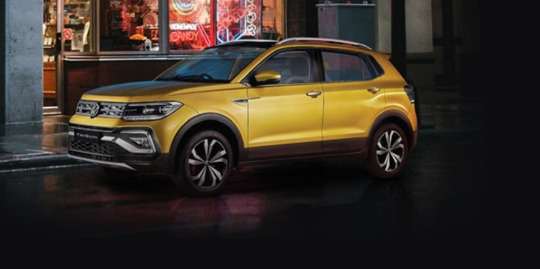
Get in Touch with Us!!!
Book Your Favorite Volkswagen Car Today!!!
Volkswagen Taigun Variants
The Volkswagen Taigun offers several variants, each with its unique set of features and characteristics. Let's explore the top contenders:
1. Volkswagen Taigun Trendline
Engine: The Taigun Trendline is powered by a 1.0-liter TSI engine, known for its fuel efficiency and performance.
Infotainment: It comes with a user-friendly infotainment system, offering smartphone connectivity and a touchscreen interface.
Safety: Standard safety features include ABS, airbags, and stability control, ensuring a secure driving experience.

Book Your Favorite Volkswagen Car Today
2. Volkswagen Taigun Comfortline
Interior Comfort: The Comfortline adds more comfort features, including better upholstery and additional interior space.
Convenience: Keyless entry, automatic climate control, and a multi-function steering wheel enhance convenience.
Advanced Safety: The Comfortline model often includes advanced safety features such as adaptive cruise control and lane-keeping assist.
3. Volkswagen Taigun Highline
Luxury Features: Highline models bring a touch of luxury with leather seats, a panoramic sunroof, and premium audio systems.
Technology: Expect advanced tech like a digital instrument cluster, larger touchscreen displays, and more connectivity options.
Performance: Highline variants often offer more potent engine options for those seeking spirited driving.
Hyundai Creta
The Hyundai Creta is known for its modern safety technologies. Here are some notable safety features:
Forward Collision-Avoidance Assist (FCA): This system detects pedestrians and vehicles in your path and can automatically apply the brakes to prevent a collision.
Lane Keeping Assist (LKA): LKA helps you maintain your lane by providing gentle steering inputs when it senses lane drifting.
Driver Attention Warning (DAW): DAW monitors your driving patterns and provides alerts if it detects signs of drowsiness or inattention.
Rear Cross-Traffic Collision-Avoidance Assist: When backing out of a parking space, this feature can warn you of approaching vehicles and apply the brakes if necessary.
Skoda Kushaq
Skoda is renowned for its commitment to safety, and the Kushaq is no exception. Here are some of its noteworthy safety features:
Multi-Collision Brake: In the event of a collision, this system can automatically apply the brakes to reduce the severity of a secondary collision.
Electronic Stability Control (ESC): ESC helps you maintain control of the vehicle in slippery or challenging road conditions.
Hill-Hold Control: This feature prevents the vehicle from rolling backward when starting on a steep incline, enhancing safety during hill starts.
ISOFIX Child Seat Mounts: The Kushaq comes equipped with ISOFIX mounts for securing child seats, ensuring the safety of your little ones.
Safety Ratings
In addition to the advanced safety features, it's essential to consider the safety ratings of these SUVs. The safety ratings are typically determined by organizations such as the National Highway Traffic Safety Administration (NHTSA) and the Insurance Institute for Highway Safety (IIHS).
Volkswagen Taigun: The Taigun has received strong safety ratings in crash tests conducted by NHTSA and IIHS, making it a top choice for safety-conscious buyers.
Hyundai Creta: The Creta has also earned high safety ratings, demonstrating Hyundai's commitment to passenger safety.
Skoda Kushaq: Skoda vehicles, including the Kushaq, are known for their robust safety engineering, and this SUV is no exception.
Conclusion
In conclusion, the "best" Taigun SUV varies from person to person. It depends on your individual preferences, needs, and budget. Volkswagen has designed each variant to cater to different tastes and requirements, ensuring there's a Taigun for everyone.
Take your time to explore the various Taigun models, test drive them, and assess which one aligns perfectly with your expectations. Whether you prioritize budget, luxury, technology, or performance, the Volkswagen Taigun has a variant that can meet your specific demands.
Ultimately, the best Taigun SUV is the one that brings a smile to your face every time you get behind the wheel and suits your lifestyle seamlessly. Enjoy your journey with the Taigun SUV that resonates with you the most.
Visit Volkswagen Phoenix Showroom Today!!!
Get in Touch with Us!!!
Book Your Favorite Volkswagen Car Today!!!
#volkswagen phoenix#volkswagen cars#volkswagenindia#volkswagen taigun#automotive#volkswagen car showroom in thrissur#volkswagen taigun price#volkswagen car showroom in malappuram#volkswagen#cars
0 notes
Text
When it comes to choosing a vehicle, safety is paramount. This is especially true for SUVs, which are often tasked with transporting families and precious cargo. In this article, we delve into the safety features and ratings of some of the safest SUVs of 2023, providing you with the information you need to make an informed decision. Safest SUVs Understanding Safety Ratings: NHTSA and IIHS Explained Before we dive into the specifics of each SUV, it's important to understand the safety ratings that these vehicles are evaluated against. Two major organizations, the National Highway Traffic Safety Administration (NHTSA) and the Insurance Institute for Highway Safety (IIHS), conduct rigorous tests to evaluate the safety of new vehicles each year. The NHTSA's ratings are based on a star system, with five stars indicating the highest level of safety. The IIHS, on the other hand, uses a tiered rating system, with "Good" being the highest rating, followed by "Acceptable," "Marginal," and "Poor." Vehicles that perform exceptionally well in their tests may also receive a "Top Safety Pick" or "Top Safety Pick+" designation. Acura MDX: A Blend of Luxury and Safety Acura MDX The Acura MDX is a midsize luxury SUV that doesn't compromise on safety. It boasts a host of advanced safety features, including collision mitigation braking, road departure mitigation, adaptive cruise control, and lane-keeping assist. These features, coupled with its robust construction, have earned it high safety ratings from both the NHTSA and IIHS. Acura RDX: Compact Yet Safe Acura RDX The Acura RDX, while smaller than the MDX, is no less safe. It comes equipped with Acura's AcuraWatch suite of safety features, which includes forward collision warning, lane departure warning, and a multi-view rear camera. Its safety is further bolstered by its ACE body structure, designed to enhance occupant protection in the event of a frontal collision. Honda CR-V: Safety for the Whole Family Honda CR-V The Honda CR-V is a popular choice among families, and for good reason. It's equipped with Honda Sensing, a suite of safety and driver-assistive technologies designed to alert you to things you might miss while driving. Plus, with its high safety ratings, you can have peace of mind knowing your family is protected. Honda HR-V: Small Size, Big Safety Honda HR-V Don't let its compact size fool you - the Honda HR-V is big on safety. It features Honda's Advanced Compatibility Engineering body structure, designed to absorb and distribute crash energy to reduce the force transferred to the cabin. It also includes a multi-angle rearview camera and available Honda Sensing features. Hyundai Palisade: A Fortress on Wheels Hyundai Palisade The Hyundai Palisade is a testament to Hyundai's commitment to safety. This three-row SUV is equipped with a plethora of safety features, including forward collision-avoidance assist, lane following assist, and safe exit assist. In addition, its sturdy construction has earned it high marks in crash tests, making it a reliable choice for families. Infiniti QX60: Luxury Meets Safety Infiniti QX60 The Infiniti QX60 blends luxury and safety seamlessly. It offers a suite of safety features, including predictive forward collision warning and forward emergency braking with pedestrian detection. These features, along with its robust construction, contribute to its impressive safety ratings. Kia Telluride: Safety in Every Journey Kia Telluride The Kia Telluride is a midsize SUV that doesn't skimp on safety. It boasts a range of safety features, including blind-spot detection, forward collision-avoidance assist, and safe exit assist. Its commitment to safety has earned it a Top Safety Pick award from the IIHS. Lexus NX: Compact Luxury with a Safety Focus Lexus NX The Lexus NX is a compact luxury SUV that places a strong emphasis on safety. It comes standard with the Lexus Safety System+,
which includes a pre-collision system with pedestrian detection, lane departure alert with steering assist, and all-speed dynamic radar cruise control. These features, along with its solid construction, contribute to its high safety ratings. Lexus RX: Setting the Standard for Safety Lexus RX The Lexus RX, one of the pioneers of the luxury SUV segment, continues to set the standard for safety. It features the Lexus Safety System+ 2.0, an integrated suite of safety technologies designed to help maintain your awareness and support your decision-making on the road. Its commitment to safety is reflected in its excellent safety ratings. Lexus UX: Safety in a Compact Package Lexus UX The Lexus UX may be the smallest SUV in the Lexus lineup, but it's big on safety. It comes standard with the Lexus Safety System+ 2.0, which includes features like a pre-collision system with pedestrian detection, lane tracing assist, and road sign assist. These features, along with its solid construction, contribute to its high safety ratings. Nissan Pathfinder: A Path to Safety Nissan Pathfinder The Nissan Pathfinder is a midsize SUV that's designed with safety in mind. It features Nissan's Safety Shield 360, a suite of six advanced safety and driver assist technologies that can help look out for you. Its safety features, coupled with its robust construction, have earned it high safety ratings from both the NHTSA and IIHS. Subaru Ascent: Safety for Every Adventure Subaru Ascent The Subaru Ascent is built for families who love to explore. It comes standard with Subaru's EyeSight Driver Assist Technology, which includes automatic pre-collision braking, adaptive cruise control, and lane keep assist. Its commitment to safety has earned it a Top Safety Pick+ award from the IIHS. Subaru Solterra: Electric and Safe Subaru Solterra The Subaru Solterra, Subaru's first all-electric SUV, is designed with safety at its core. It features Subaru's EyeSight Driver Assist Technology, which includes features like pre-collision braking, lane departure prevention, and advanced adaptive cruise control with lane centering. Its safety features and solid construction make it a safe choice for eco-conscious drivers. Tesla Model Y: Electric Safety Innovation Tesla Model Y The Tesla Model Y is a testament to Tesla's commitment to safety. This all-electric SUV is equipped with Tesla's Autopilot features, which include safety measures like emergency braking, collision warning, and blind-spot monitoring. Furthermore, its low center of gravity, rigid body structure, and large crumple zones provide unparalleled protection. Toyota Highlander: A High Standard of Safety Toyota Highlander The Toyota Highlander is a midsize SUV that sets a high standard for safety. It comes standard with Toyota Safety Sense 2.5+, a suite of active safety features that includes a pre-collision system with pedestrian detection, lane departure alert with steering assist, and dynamic radar cruise control. Its commitment to safety is reflected in its excellent safety ratings. Volkswagen ID.4: Electric and Secure Volkswagen ID.4 The Volkswagen ID.4 is an all-electric SUV that doesn't compromise on safety. It's equipped with a host of safety features, including forward collision warning and autonomous emergency braking with pedestrian monitoring. These features, along with its robust construction, contribute to its high safety ratings. Volvo XC90: Safety is in its DNA Volvo XC90 The Volvo XC90 is a luxury SUV that exemplifies Volvo's long-standing commitment to safety. It comes equipped with a host of safety features, including a blind spot information system with steer assist, cross traffic alert, and a 360° camera that helps make parking easier. Its safety is further bolstered by its robust construction, which includes a high-strength steel safety cage and energy-absorbing interior. FAQs What makes an SUV safe? Safety
in an SUV is determined by a variety of factors, including its construction, safety features, and performance in crash tests conducted by organizations like the NHTSA and IIHS. Are larger SUVs safer than smaller ones? While larger SUVs tend to fare better in crash tests due to their size and weight, many smaller SUVs also achieve high safety ratings thanks to advanced safety technologies and robust construction. What safety features should I look for in an SUV? Key safety features to look for in an SUV include automatic emergency braking, forward collision warning, lane departure warning, blind-spot detection, and rearview cameras. Are electric SUVs safe? Electric SUVs are subject to the same safety standards as their gasoline counterparts and often come equipped with advanced safety features. They also have a lower center of gravity, which can reduce the risk of rollovers. How often are safety ratings updated? Safety ratings are typically updated annually as new models are released and as testing methodologies evolve. #Wiack #Car #CarInsurance #CarRental #CarPrice #AutoLoans
0 notes
Text
When it comes to choosing a vehicle, safety is paramount. This is especially true for SUVs, which are often tasked with transporting families and precious cargo. In this article, we delve into the safety features and ratings of some of the safest SUVs of 2023, providing you with the information you need to make an informed decision. Safest SUVs Understanding Safety Ratings: NHTSA and IIHS Explained Before we dive into the specifics of each SUV, it's important to understand the safety ratings that these vehicles are evaluated against. Two major organizations, the National Highway Traffic Safety Administration (NHTSA) and the Insurance Institute for Highway Safety (IIHS), conduct rigorous tests to evaluate the safety of new vehicles each year. The NHTSA's ratings are based on a star system, with five stars indicating the highest level of safety. The IIHS, on the other hand, uses a tiered rating system, with "Good" being the highest rating, followed by "Acceptable," "Marginal," and "Poor." Vehicles that perform exceptionally well in their tests may also receive a "Top Safety Pick" or "Top Safety Pick+" designation. Acura MDX: A Blend of Luxury and Safety Acura MDX The Acura MDX is a midsize luxury SUV that doesn't compromise on safety. It boasts a host of advanced safety features, including collision mitigation braking, road departure mitigation, adaptive cruise control, and lane-keeping assist. These features, coupled with its robust construction, have earned it high safety ratings from both the NHTSA and IIHS. Acura RDX: Compact Yet Safe Acura RDX The Acura RDX, while smaller than the MDX, is no less safe. It comes equipped with Acura's AcuraWatch suite of safety features, which includes forward collision warning, lane departure warning, and a multi-view rear camera. Its safety is further bolstered by its ACE body structure, designed to enhance occupant protection in the event of a frontal collision. Honda CR-V: Safety for the Whole Family Honda CR-V The Honda CR-V is a popular choice among families, and for good reason. It's equipped with Honda Sensing, a suite of safety and driver-assistive technologies designed to alert you to things you might miss while driving. Plus, with its high safety ratings, you can have peace of mind knowing your family is protected. Honda HR-V: Small Size, Big Safety Honda HR-V Don't let its compact size fool you - the Honda HR-V is big on safety. It features Honda's Advanced Compatibility Engineering body structure, designed to absorb and distribute crash energy to reduce the force transferred to the cabin. It also includes a multi-angle rearview camera and available Honda Sensing features. Hyundai Palisade: A Fortress on Wheels Hyundai Palisade The Hyundai Palisade is a testament to Hyundai's commitment to safety. This three-row SUV is equipped with a plethora of safety features, including forward collision-avoidance assist, lane following assist, and safe exit assist. In addition, its sturdy construction has earned it high marks in crash tests, making it a reliable choice for families. Infiniti QX60: Luxury Meets Safety Infiniti QX60 The Infiniti QX60 blends luxury and safety seamlessly. It offers a suite of safety features, including predictive forward collision warning and forward emergency braking with pedestrian detection. These features, along with its robust construction, contribute to its impressive safety ratings. Kia Telluride: Safety in Every Journey Kia Telluride The Kia Telluride is a midsize SUV that doesn't skimp on safety. It boasts a range of safety features, including blind-spot detection, forward collision-avoidance assist, and safe exit assist. Its commitment to safety has earned it a Top Safety Pick award from the IIHS. Lexus NX: Compact Luxury with a Safety Focus Lexus NX The Lexus NX is a compact luxury SUV that places a strong emphasis on safety. It comes standard with the Lexus Safety System+,
which includes a pre-collision system with pedestrian detection, lane departure alert with steering assist, and all-speed dynamic radar cruise control. These features, along with its solid construction, contribute to its high safety ratings. Lexus RX: Setting the Standard for Safety Lexus RX The Lexus RX, one of the pioneers of the luxury SUV segment, continues to set the standard for safety. It features the Lexus Safety System+ 2.0, an integrated suite of safety technologies designed to help maintain your awareness and support your decision-making on the road. Its commitment to safety is reflected in its excellent safety ratings. Lexus UX: Safety in a Compact Package Lexus UX The Lexus UX may be the smallest SUV in the Lexus lineup, but it's big on safety. It comes standard with the Lexus Safety System+ 2.0, which includes features like a pre-collision system with pedestrian detection, lane tracing assist, and road sign assist. These features, along with its solid construction, contribute to its high safety ratings. Nissan Pathfinder: A Path to Safety Nissan Pathfinder The Nissan Pathfinder is a midsize SUV that's designed with safety in mind. It features Nissan's Safety Shield 360, a suite of six advanced safety and driver assist technologies that can help look out for you. Its safety features, coupled with its robust construction, have earned it high safety ratings from both the NHTSA and IIHS. Subaru Ascent: Safety for Every Adventure Subaru Ascent The Subaru Ascent is built for families who love to explore. It comes standard with Subaru's EyeSight Driver Assist Technology, which includes automatic pre-collision braking, adaptive cruise control, and lane keep assist. Its commitment to safety has earned it a Top Safety Pick+ award from the IIHS. Subaru Solterra: Electric and Safe Subaru Solterra The Subaru Solterra, Subaru's first all-electric SUV, is designed with safety at its core. It features Subaru's EyeSight Driver Assist Technology, which includes features like pre-collision braking, lane departure prevention, and advanced adaptive cruise control with lane centering. Its safety features and solid construction make it a safe choice for eco-conscious drivers. Tesla Model Y: Electric Safety Innovation Tesla Model Y The Tesla Model Y is a testament to Tesla's commitment to safety. This all-electric SUV is equipped with Tesla's Autopilot features, which include safety measures like emergency braking, collision warning, and blind-spot monitoring. Furthermore, its low center of gravity, rigid body structure, and large crumple zones provide unparalleled protection. Toyota Highlander: A High Standard of Safety Toyota Highlander The Toyota Highlander is a midsize SUV that sets a high standard for safety. It comes standard with Toyota Safety Sense 2.5+, a suite of active safety features that includes a pre-collision system with pedestrian detection, lane departure alert with steering assist, and dynamic radar cruise control. Its commitment to safety is reflected in its excellent safety ratings. Volkswagen ID.4: Electric and Secure Volkswagen ID.4 The Volkswagen ID.4 is an all-electric SUV that doesn't compromise on safety. It's equipped with a host of safety features, including forward collision warning and autonomous emergency braking with pedestrian monitoring. These features, along with its robust construction, contribute to its high safety ratings. Volvo XC90: Safety is in its DNA Volvo XC90 The Volvo XC90 is a luxury SUV that exemplifies Volvo's long-standing commitment to safety. It comes equipped with a host of safety features, including a blind spot information system with steer assist, cross traffic alert, and a 360° camera that helps make parking easier. Its safety is further bolstered by its robust construction, which includes a high-strength steel safety cage and energy-absorbing interior. FAQs What makes an SUV safe? Safety
in an SUV is determined by a variety of factors, including its construction, safety features, and performance in crash tests conducted by organizations like the NHTSA and IIHS. Are larger SUVs safer than smaller ones? While larger SUVs tend to fare better in crash tests due to their size and weight, many smaller SUVs also achieve high safety ratings thanks to advanced safety technologies and robust construction. What safety features should I look for in an SUV? Key safety features to look for in an SUV include automatic emergency braking, forward collision warning, lane departure warning, blind-spot detection, and rearview cameras. Are electric SUVs safe? Electric SUVs are subject to the same safety standards as their gasoline counterparts and often come equipped with advanced safety features. They also have a lower center of gravity, which can reduce the risk of rollovers. How often are safety ratings updated? Safety ratings are typically updated annually as new models are released and as testing methodologies evolve. #Wiack #Car #CarInsurance #CarRental #CarPrice #AutoLoans
0 notes
Text

Common Mistakes New Drivers Make and How to Steer Clear of Them: Your Comprehensive Guide
Embarking on the journey of becoming a skilled driver is an exciting milestone. However, it's common for new drivers to encounter certain pitfalls along the way that can hinder their progress. In this guide, brought to you by Drive Well Driving School, we'll delve into the most frequent blunders made by new drivers and provide you with valuable insights on how to sidestep these challenges. By learning from the experiences of others, you'll be better equipped to navigate the road with confidence and finesse.
Overconfidence Behind the Wheel: Mistake: It's easy to get carried away with the thrill of driving, but overconfidence can lead to reckless behavior and poor decision-making.
Solution: Stay humble and remind yourself that driving is a skill that requires ongoing learning. Always follow traffic rules, keep a safe following distance, and avoid distractions like texting or loud music.
Ignoring Basic Vehicle Maintenance: Mistake: Neglecting routine vehicle maintenance can compromise your safety and the well-being of your car.
Solution: Regularly check your tire pressure, brakes, and fluid levels. Get your car serviced as recommended by the manufacturer to ensure it's in top condition.
Failing to Use Turn Signals: Mistake: Many new drivers forget to use their turn signals, leading to confusion and potential accidents.
Solution: Make it a habit to use your signals well in advance of turning or changing lanes. This simple action communicates your intentions to other drivers and keeps everyone on the same page.
Following Too Closely: Mistake: Tailgating doesn't just annoy other drivers – it's a dangerous habit that reduces your reaction time.
Solution: Adhere to the "two-second rule." Maintain a distance of at least two seconds behind the vehicle in front of you. Increase this gap in adverse weather conditions.
Speeding and Ignoring Speed Limits: Mistake: Speeding is a leading cause of accidents, especially for new drivers who may not yet have a solid grasp of their vehicle's capabilities.
Solution: Obey posted speed limits at all times. Remember, arriving safely is more important than getting somewhere a few minutes earlier.
Multi-Tasking While Driving: Mistake: Using your phone, eating, or grooming while driving diverts your attention from the road.
Solution: Keep your focus solely on driving. If you need to attend to something, pull over in a safe location.
Lack of Observation at Intersections: Mistake: Failing to thoroughly check for oncoming traffic and pedestrians at intersections can lead to collisions.
Solution: Practice the "Look Left, Look Right" rule and ensure the path is clear before proceeding, even if you have the right of way.
Incorrect Merging and Lane Changing: Mistake: New drivers often struggle with merging onto highways and changing lanes smoothly.
Solution: Signal your intention early, match your speed with the flow of traffic, and merge or change lanes when it's safe to do so.
Conclusion: Becoming a skilled and responsible driver is a journey filled with learning opportunities. By being aware of these common mistakes and actively working to avoid them, you're setting yourself up for a safe and enjoyable experience on the road. Remember, Drive Well Driving School is here to support you every step of the way. Happy driving!
Visit - https://www.drivewelldrivingschool.com/common-mistakes-new-drivers-make-and-how-to-avoid-them-an-in-depth-guide/
#driving schools in ashburn va#best driving school in ashburn#behind the wheel driving school near me#driving schools ashburn va#driving schools in loudoun county va#driving schools near me#across the spiderverse
0 notes
Text
Explore the Best Features of the 2023 Hyundai i20

Hyundai's design DNA is reflected in the dynamic exterior and opulent interior of the brand-new i20. Its alluring presence weaves a seductive spell, and its built-in features increase your sense of comfort and convenience. The Hyundai i20 stands head and shoulders above the competition. To breathe clean air when traveling, use an air purifier. The cabin is kept in good condition. It's recommended to reach out to PPS Hyundai Kochi or visit a PPS Hyundai dealership closer to you, to expericne the features close by.
An overview of the features typically found in the Hyundai i20, based on the previous model and the trends in the automotive industry.
Stylish Exterior: The Hyundai i20 is known for its modern and sporty design. It often features sleek lines, a prominent grille, and stylish alloy wheels, giving it an attractive and dynamic appearance.
Spacious Interior: The i20 generally offers a comfortable and spacious cabin, making it suitable for both driver and passengers. It may include features like adjustable seating, ample legroom, and sufficient cargo space.
Infotainment System: Hyundai models often come equipped with an advanced infotainment system. Depending on the variant and trim level, the i20 may offer a Hyundai i20 Multi Information display, smartphone integration (Apple CarPlay and Android Auto), Bluetooth connectivity, and audio controls mounted on the steering wheel.
Safety Features: Hyundai places importance on safety, and the i20 may include a range of safety features. These might include multiple airbags, Hyundai i20 smart key features, anti-lock braking system (ABS), electronic stability control (ESC), rear parking sensors or camera, lane departure warning, and forward collision warning. The staff at PPS Hyundai Dealer Kochi helps understand safety and its importance while purchasing.
Advanced Technology: Hyundai incorporates various technological advancements into its vehicles. The i20 could feature advanced driver-assistance systems such as adaptive cruise control, automatic emergency braking, blind-spot monitoring, and rear cross-traffic alert, depending on the trim level.
Efficient Engine Options: The i20 typically offers a range of engine options to suit different preferences. These may include both petrol and diesel engines with varying power outputs and fuel efficiency.
What are the safety features of Hyundai i20?
The Hyundai i20 typically offers a range of safety features to ensure the well-being of its occupants. While the specific safety features can vary depending on the trim level and market, here are some common safety features found in the Hyundai i20:
Airbags: The i20 is typically equipped with multiple airbags, including front airbags for the driver and front passenger. Some models may also include side and curtain airbags for enhanced protection.
Anti-lock Braking System (ABS): ABS helps prevent the wheels from locking up during braking, enabling the driver to maintain steering control. It enhances stability and reduces the risk of skidding.
Electronic Stability Control (ESC): ESC is a system that helps maintain vehicle stability during various driving conditions. It assists in preventing loss of control by selectively applying brakes to individual wheels and adjusting engine power.
Hill-start Assist Control (HAC): HAC is a feature that prevents the vehicle from rolling back on an incline when starting from a stop. It holds the brakes briefly, allowing the driver to transition smoothly from the brake pedal to the accelerator.
Rear Parking Sensors/Camera: ManyHyundai i20 2023 models come with rear parking sensors or a rearview camera to assist in parking and maneuvering in tight spaces. These features provide audible or visual alerts to help avoid obstacles while reversing.
Tire Pressure Monitoring System (TPMS): TPMS monitors the air pressure in the tires and alerts the driver if any tire pressure is below the recommended level. It helps ensure proper tire inflation and enhances safety.
Seatbelt Pretensioners: The i20 typically includes seatbelt pretensioners, which automatically tighten the seatbelts during certain types of collisions. This helps reduce the forward movement of occupants and enhances the effectiveness of the seatbelts.
ISOFIX Child Seat Anchors: The i20 often features ISOFIX child seat anchors, which provide a secure and standardized attachment point for compatible child seats. This system improves child safety by ensuring proper installation.
What is the driving range of i20?
The driving range of the Hyundai i20 can vary depending on several factors, including the engine type, fuel efficiency, fuel tank capacity, driving conditions, and driving style. As of my knowledge cutoff in September 2021, I don't have specific information about the driving range of the Hyundai i20, as it can vary based on the variant, trim level, and market.
The driving range is typically determined by multiplying the average fuel efficiency of the vehicle by the fuel tank capacity. For example, if the i20 has an average fuel efficiency of 15 kilometers per liter and a fuel tank capacity of 50 liters, the estimated driving range would be around 750 kilometers (15 km/L x 50 L = 750 km). This calculation is typically for I20 Petrol engine cc.
However, it's important to note that real-world driving conditions and individual driving habits can significantly impact the actual driving range. Factors such as traffic, road conditions, terrain, and driving style can affect fuel consumption and, consequently, the driving range.
To obtain the most accurate and up-to-date information about the driving range of a specific model and year of the Hyundai i20, I recommend referring to the official Hyundai website, the owner's manual, or contacting a Hyundai dealership. They will have the most precise details regarding the driving range based on the specific i20 variant and trim level in your region.
Is i20 safe on highway?
The Hyundai i20 is designed with safety in mind and typically offers a range of safety features to enhance occupant protection on the highway and other road conditions. These safety features may include multiple airbags, anti-lock braking system (ABS), electronic stability control (ESC), hill-start assist control (HAC), rear parking sensors or camera, and more.
However, it's important to note that the safety of any vehicle on the highway is influenced by various factors, including driver behavior, adherence to traffic laws, road conditions, and other external factors. While the i20 provides safety features to mitigate risks, it is ultimately the responsibility of the driver to drive safely and attentively.
To ensure a safe experience on the highway, it's recommended to follow safe driving practices, such as maintaining a safe distance from other vehicles, adhering to speed limits, using turn signals appropriately, and remaining focused on the road. Additionally, regular vehicle maintenance and proper tire care can contribute to highway safety.
Before purchasing a vehicle, it's advisable to review safety ratings and assessments provided by reputable organizations such as the National Highway Traffic Safety Administration (NHTSA) or the European New Car Assessment Programme (Euro NCAP) to gain further insights into the safety performance of the Hyundai i20 or any other vehicle you are considering.
Ultimately, while the Hyundai i20 is designed with safety features, safe driving practices and cautious behavior on the highway are crucial for a safe and enjoyable driving experience.PPS Hyundai Kozhikode is one of the reputed showrooms that provide all the relevant information on the safety aspect of the Hyundai i20.Final Words:
Please note that the features mentioned above are general expectations based on Hyundai's past models and industry trends. For accurate and detailed information about the specific features of the 2023 Hyundai i20, take a test drive at PPS Hyundai Showroom Kochi to get a sense of the features before purchasing the thrilling Hyundai i20.
0 notes
Photo
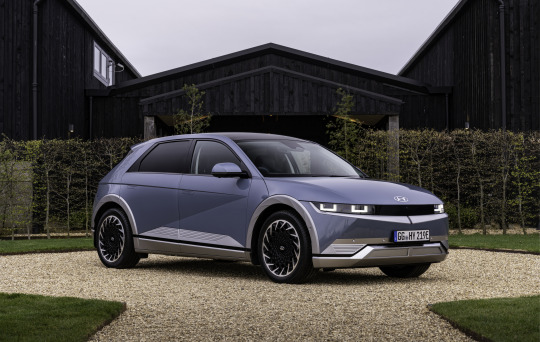
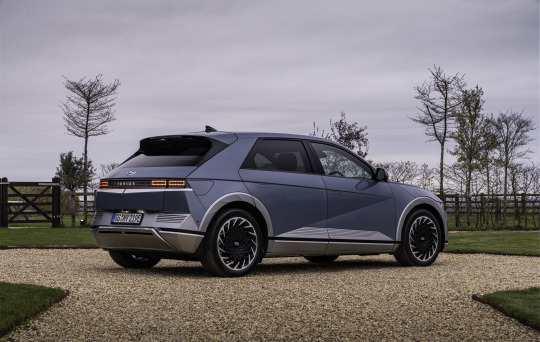
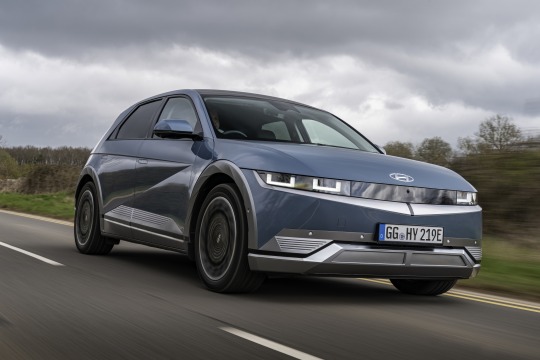
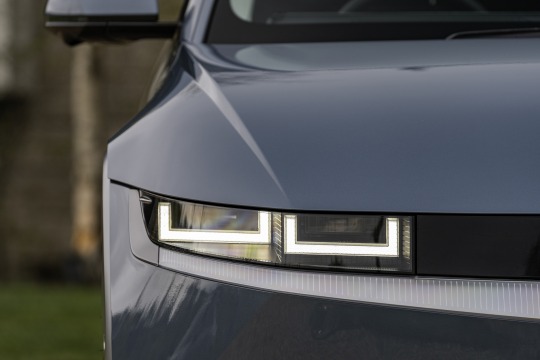
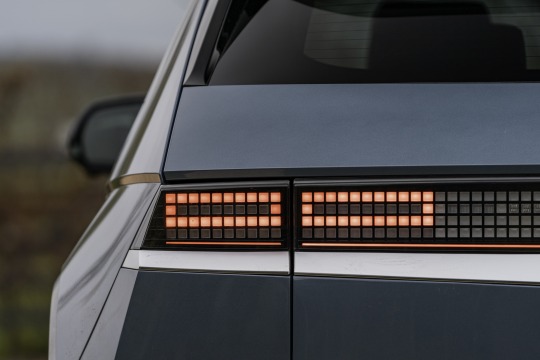
Hyundai Announces IONIQ 5 Pricing & Specs
Hyundai Motor UK has announced the pricing and specification of IONIQ 5, the first car in the new IONIQ brand and the first Hyundai built on a new dedicated Electric-Global Modular Platform.
IONIQ 5’s design explores a new design freedom offered by a dedicated BEV platform and mirrors the design of the 45 concept first seen at the 2019 Frankfurt Motor Show. The 45 concept was in itself inspired by the original Hyundai Pony Coupe Concept from 1974. The IONIQ 5 highlights Hyundai’s 45-year journey to become a part of customer’s lifestyles, creating a common thread from past to present and future.
The IONIQ 5 is built upon Hyundai Motor Group’s dedicated battery electric vehicle architecture called Electric-Global Modular Platform (E-GMP), enabling it to have unique proportions on an elongated wheelbase. With E-GMP, IONIQ 5 offers innovative interior design with eco-friendly materials in many touchpoints; strong performance mated with ultra-fast charging, a Vehicle-to-Load (V2L) function as well as advanced connectivity and driver assistance features that will offer the ultimate in-car experience while ensuring a high level of safety.
E-GMP provides IONIQ 5 flexibility in powertrain options, with customers having the choice of 4 battery and drive types; a 58kWh rear wheel drive with a combined range of up to 240 miles1, a 73kWh rear wheel drive with a combined range of up to 300 miles1, or a 73kWh all-wheel drive with a range of up to 287 miles1. IONIQ 5 features 800V charging as standard, which when combined with a 350kW ultra-rapid charger will provide 80% charge in just 18 minutes and 100km of driving range in 5 minutes. The system also supports both domestic wall box charging and mainstream public 400V high speed charging, using the motor and the inverter to convert the voltage from 400V to 800V for optimized charge times whenever possible.
IONIQ 5 will be available in 3 specification levels, SE Connect, Premium, Ultimate, which join the comprehensively equipped special launch edition Project 45.
Starting from £36,995, the IONIQ 5 SE Connect 58 kWh rear wheel drive delivers on Hyundai’s renowned comprehensive standard specification levels and includes 19” alloy wheels, cloth upholstery, produced using naturally derived polyester resin, driver and front passenger seat height adjustment, sliding rear seat adjustment, interior mood lighting, 12.3” LCD audio, visual and navigation system with DAB, Apple Car Play™ and Android Auto™, LCD drivers instrument cluster, wireless phone charging for compatible devices, rear view camera, LED Multi-Faceted Reflector headlamps, LED stop, tail and turn lamps, rear parking sensors, electric parking brake, Navigation based Smart Cruise Control (NSCC) is standard, which will automatically adjust speed to stay within the speed limit and also automatically adjust speed to cater for road layout., Highway Drive Assist (HDA), Intelligent Speed Limit Assist (ISLA), Lane Keep Assist with Lane Following Assist (LKAS + LFA), Driver Attention Alert and frunk storage under the signature clamshell bonnet.
Available from £39,295, the IONIQ 5 Premium 58kWh rear wheel drive builds on the SE Connect trim by adding a 4 way power driver’s seat, heated driver and front passenger seats and steering wheel, auto dimming rear view mirror, dual LED projector headlamps, power tailgate, chrome side molding, Highway Drive Assist Level 2 (HDA II) with automatic lane change function, Forward Collision Assist with Junction function (FCA JX) and Blindspot Collision Avoidance assist (BCA). Premium trim also offers customers the optional Vehicle 2 Load pack (V2L). The V2L function allows customers to freely use or charge any electric devices, suppling up to 3.6 kW of power. Using a converter, customers can charge high-power electric equipment, consumer electronics or even charge another electric vehicle. The IONIQ 5 Premium is also available with the 73kWh battery in rear wheel and all- wheel drive.
The IONIQ 5 Ultimate 58kWh rear wheel drive completes the IONIQ range with a high specification including leather seat coverings, solar and privacy glass, chrome door garnish, black gloss beltline, electrically adjustable and ventilated front seats, heated rear seats, BOSE premium sound system, head up display with augmented reality, standard Vehicle 2 Load (V2L), sliding center console and alloy pedals. Customers can also specify the Eco Pack which comprises Battery Heating system and Heat Pump and the Tech Pack with Front Memory Seats, Relaxation Premium Seats, BVM (Blind View Monitor), PCA ( Parking Collision Avoidance Assist - Reverse), RSPA (Remote Smart Parking Assist), SVM ( Surround View Monitor). The Ultimate specification is also available with the 73kWh battery in rear wheel and all- wheel drive, both of which upgrade to 20” alloy wheels.
All IONIQ 5 models come with a 1 year subscription to the IONITY charging network, Hyundai’s industry leading 5 Year Unlimited Mileage Warranty, 8 Year/100,000 Mile High Voltage Battery Warranty, 5 Year Annual Health Check, 3 year MapCare navigation update program, Roadside Assistance package, and 12 Year Anti Corrosion Warranty.
32 notes
·
View notes
Text
@ccfstarter
OPEN
The empress of meticulous analysis and thorough, well-planned, multi-point countermeasures, when Ada was left with only her father's old motorbike as as a method of transportation, it was natural for her to conduct research. Her car was still being repaired following the impromptu shootout she was unjustly subjected to by a fault not her own. She wasn't opposed to taking public transit while she completed her safety classes and and made sure the Triumph Bonneville Scrambler was properly maintenance before she took it on the road. She used to ride behind her father, so thankfully she was somewhat familiar with the power the tiny vehicle possessed. Yet, that didn't alleviate the anxiety of the unknown. As a proponent of safety, there were just too many unknown variables associated with motorbike handling. She was adamant about being well prepared with the appropriate actions to take should unpredictable riding situations arise. Not to mention having confidence in her skill and good judgement. After several practice courses -- comprehensive lessons on collision avoidance maneuvers, advanced turning, control tips and braking techniques -- she felt more than adequate to take the helm.
What she hadn't expected was the emotional aspect. Her father adored that motorbike, and her first time perched on the leather seat overwhelmed her with an indescribable sensation, she immediately made a call to Doctor Williams-Jacoba to help her through the mounting panic attack. It had been a few weeks since she'd been acquainted with the machine, and truth be told, she was very fond of it. In her own way. Naturally, as remedial as it seemed, she obeyed every traffic regulation to the letter and always reviewed her mental safety checklist before hopping aboard.

Headlights and taillights. Strong illumination. Turn signals. In perfect working order. Brakes. Responding adequately. Fuel and Oil. At capacity. Tire pressure. Acceptable. Mirrors and Handlebars...
Ada adjusted the tiny mirrors as she did every morning to make sure it was perfectly aligned with the view behind her. She didn’t notice her visually bizarre ritual was being observed until she began testing the horn. She caught the amused smirk out of her peripherals and turned to confirm it was her they were directing it at. Unsure if the wave of amusement she was sensing from them was of malicious intent she pressed her lips together tentatively. She'd been subjected to far too many unpleasant interactions because she was incapable of discerning that she was being made fun of.
"It's important to take your vehicle safety seriously," she defended, clasping the buttons of her gloves. "Motorcycle riding can be very dangerous if proper precautions are not taken. Did you know that motorcyclists were 28 times more likely to die in a traffic accident. So..."
#( &. — STARTERS )#( &. — OPEN )#tw : mentions of death#tw : mentions of vehicle accidents#tw : mentions of panic attacks#tw : anxiety#ccfstarter
2 notes
·
View notes
Text
Chrysler Pacifica Pinnacle and Kia Carnival SX: Minivans are BACK Part 2
Words and Photos By Michael Hozjan
Kia Carnival SX:
Take a look at the remaining players in the minivan market; you’ve got the Toyota Sienna, Honda’s Odyssey, Chrysler’s Grand Caravan and last week’s subject, the Pacifica. On the surface they all look fairly alike. Sure there might be an accent line here or there in an attempt to differentiate them, but squint your eyes and the tapered nose and the silhouettes are similar - cute and soft. Chrysler changed the front-end treatment on this year’s Pacifica to give it a more rugged look with an SUV-like grille.
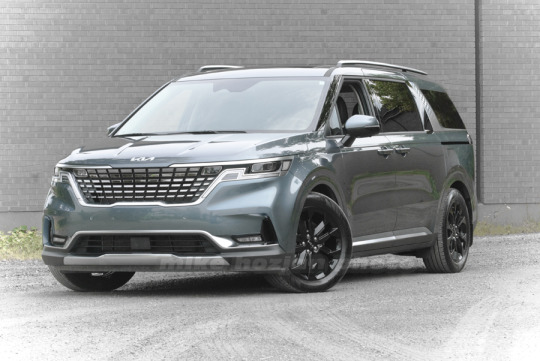
Now take a look at Kia’s latest venture. In the last couple of years Kia’s designers have knocked more than one model out of the ballpark and this year they’ve added muscular looks to a minivan. Yes Kia refers to it as an MPV for multi-purpose vehicle (how they’re getting away with using Mazda’s old moniker I have no idea). I’m pretty sure that you won’t think soccer mom when you see the Carnival. With large 19” blacked out aluminum wheels, a long square snout highlighted by lights fading into the chrome grill and aggressive looking vents on the front corners, this thing screams business.
Dollars
While design may or may not make or break a sale it is a major influence in the final decision, but the Carnival has another ace up its sleeve and that is its price.
Over the years I’ve repeatedly stated that Kias offer more bang for the buck and the Carnival is no exception. The base model, the LX, starts out at $36,760 and my top of the line tester came in at $50,560. Compare that to the base Pacifica at $45,765 and the Pinnacle at $63,265 or Toyota’s Sienna LE front wheel drive at $42,349 and the all-wheel-drive Limited at $60,824 and Honda’s base Odyssey at $45,590 and their top dog the touring at $56,790 and the Kia looks sweeter and sweeter.
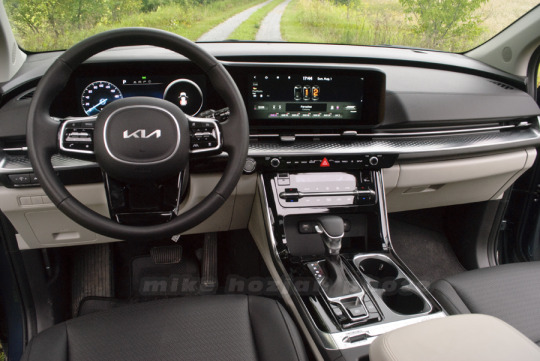
Five trim levels make up the Carnival line up; LX, LX+, EX, EX+ and SX. The base model gives you a heated windshield, rear parking sensors as well as advanced forward collision avoidance and lane follow. Stepping up to the LX+ ($40,260) add wireless phone charging, power sliding doors and liftgate, smart key and multi-zone climate controls. The $44 grand EX adds a couple more driver assists, LED taillights and 19” wheels, plus a smartphone app that allows you to remotely start, lock, unlock the truck. At $47,560 the EX+ gives you a 12.3” multimedia screen, like size digital instrument cluster a surround view monitor as well as LED head and fog lights. The king of the line up, the $50,560 SX, comes with dual sunroofs, Bose premium audio system, leather seating passenger view monitor.
And Sense
We obviously buy minivans to move people and cargo and this is where the two subjects get interesting. Starting at the back I was surprised to learn that the Kia has the upper hand in space with the third row in place, 40.2 cu.ft. to the Pacifica’s 32.3 cu.ft. My girlfriend loved the Pacifica’s clean deep well behind the third row to keep the groceries in place. The Kia’s looked too industrial with its exposed hinges.
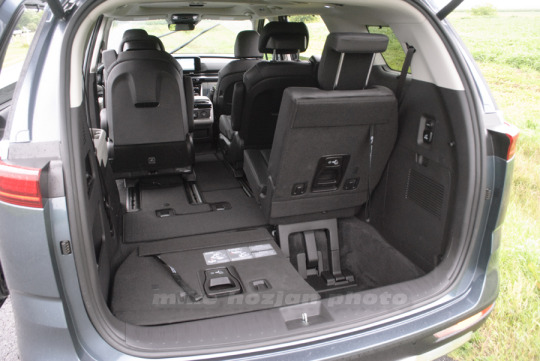
Accessing the third row is best done if you slide the second row lounge chairs inboard. Yes you read that right, not only do they move from front to back but also left to right.
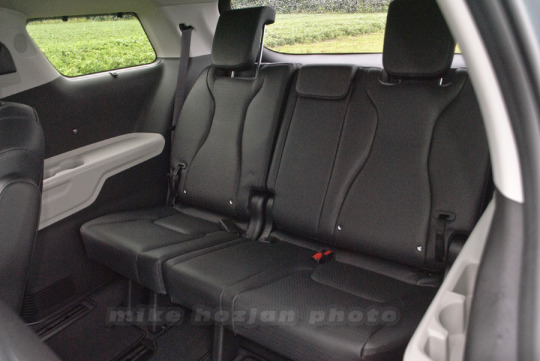
Folding the third row is a snap with the Chrysler with switches mounted on the back pillar to activate the various motors, the Kia takes some manual force – but will not break down. With the rear seats folded into their respective cubbyholes, the Kia stows 86.9 cu.ft. of gear to the Pacifica’s 87.5. My Kia came with the fabulous, executive alluring, lounge chairs. Yes they are every bit as comfortable as they look. While they add credence to the company limo I was talking about last week, they do not fold out of the way. So storage is confined to that same old 86.9 cu.ft. While the Pinnacle does not have second row stow and go seats, (lesser Pacificas do) the second row does fold up against the front buckets and can be removed – heavy as they are – to give you enough room to carry a 4x8 foot sheet of plywood in the 165 cu.ft. cargo bay. Like the Pacifica the lesser trim levels of the Carnival (the LX through to EX+) have removable second row seats expanding the cargo volume to 168 cu.ft.
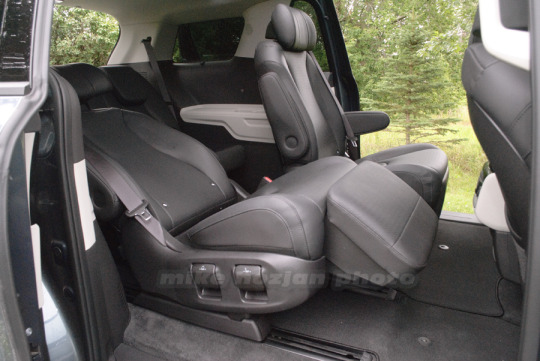
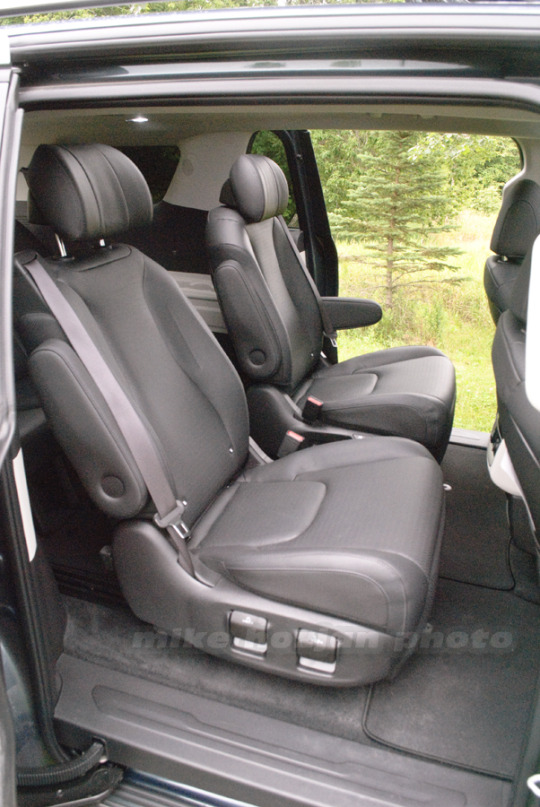
Heated front seats, tri-zone automatic climate control, and sunshades for the back rows make this a desirable cabin whether you’re shuttling your clients to the airport or moving the in-laws back home. If you’re counting, there are nine USB ports dotting the cabin and there's a handy 12-volt outlet in the rear.
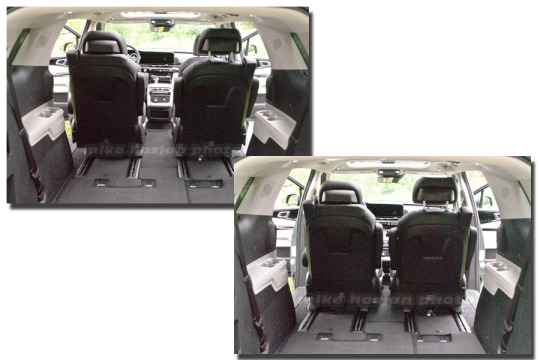
Above: Second row lounge chairs slide in for easier access to third row or or out to carry longer items.
Behind the wheel
The front buckets are comfortable and not only look, but feel like they came out of a sports sedan with excellent bolstering on the seat backs. Adding to the cockpit’s comfort is the center console’s wide armrest incorporating drink cubbies and a wireless charging tray,
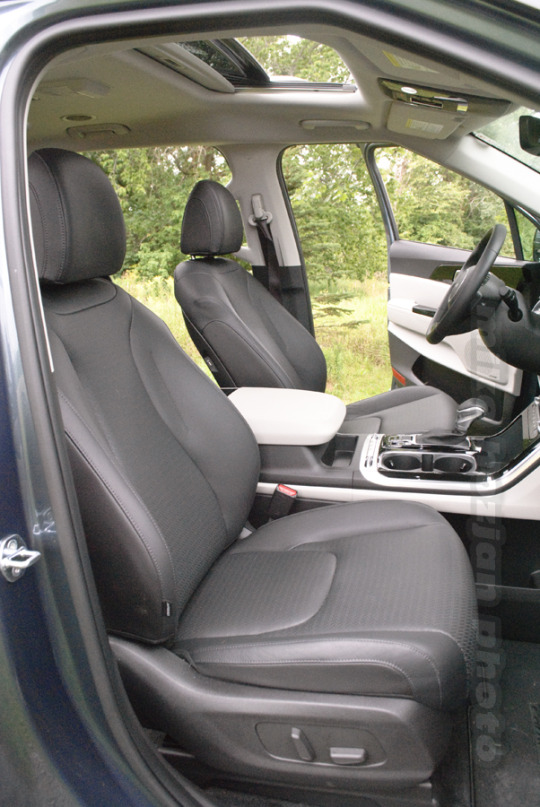
A modern looking dash is a change from the usual fluff and the infotainment centre looks spectacular, but the audio system works backwards in all of my recent Kia encounters. Example; going up the sat radio stations from 6 to say 18 you’d think you would have to press the steering wheel nub up, but no, you have to go down?!? What bicycle riding genius thought of this! Worse yet, the audio system does not let you tailor the order to your taste but numerically. You say you’ll get used to it…I shouldn’t have to. It’s called intuitive touch. Ok I’ve vented.
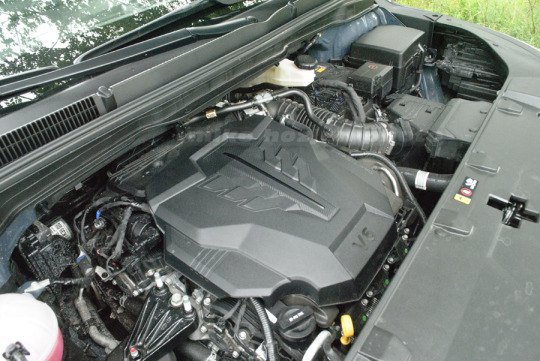
The Carnival comes with one power package, a class leading 3.5L, 290 horsepower, V6 with 262 lb.-ft. of torque connected to a smooth shifting non-CVT, 8-speed automatic that can tow 3,500 lbs. Unfortunately there’s no all-wheel-drive package available - yet. While you won’t be setting any breakneck speeds even if you use the Sport mode, it does make this minivan, um, corporate hauler, feel quicker than its competitors sending you to 100kph in just over 7 seconds. I kept mine in Eco mode to see what kind of fuel consumption I could get and was still impressed with its acceleration. I mustered an impressive 9.4L/100 kilometers. The handling is well balanced and predictable with no brake fade.
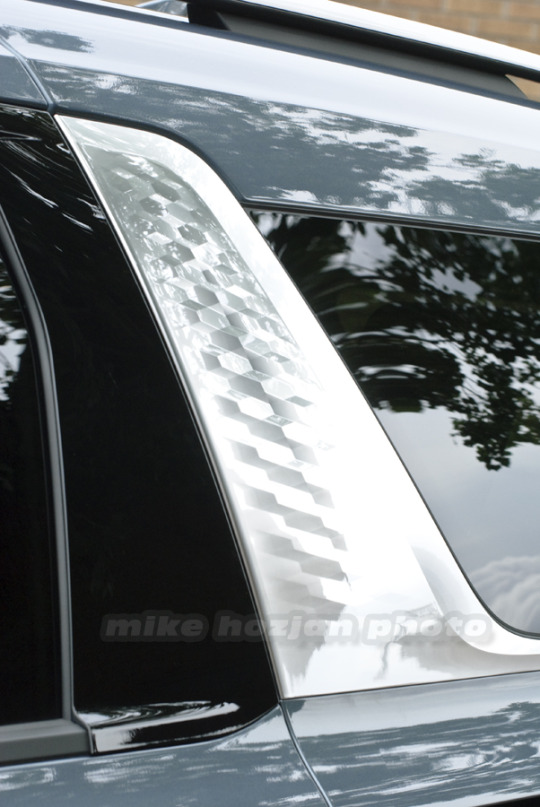
Above: No attention to detail is spared.
More a boardroom than a minivan cabin, the Carnival’s interior is serenely quite. The multi-link rear suspension soaks up road irregularities and sends barely a shudder through the greenhouse. I had to pick up over a dozen cinder blocks while my truck was out for a wheel alignment and the Kia surprised me with its smooth ride even under a heavy load, the back end never bottomed out. Kudos.
The Verdict
There’s a lot to like about the Carnival, from the old school automatic transmission to the smooth revving V6. As much as I love the lounge chairs that look like they’ve been pillaged from a Maybach, for my personal priorities I’d go for the regular, removable second row seats. Call me crazy but I’d love to see a sportier handling package made available to go with the macho design.
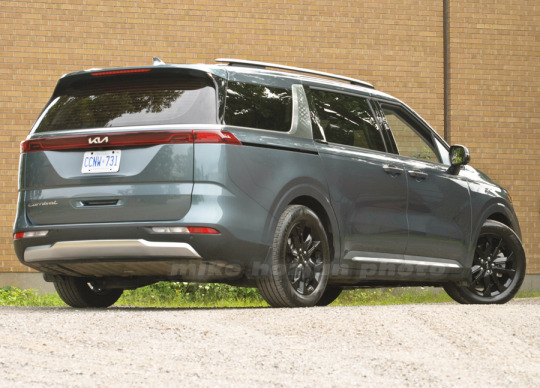
Will the Carnival steal some of the market share away from SUVs? Hard to say, with its easier access to the third row, lower lift over and better maneuverability than an SUV it makes sense, one thing is certain it’ll give Toyota, Honda and Chrysler a run for their money.
#kia#minivan#suv#chrysler#pacifica#toyota#sienna#honda#odyssey#soccer mom#grand caravan#mpv#carnival
1 note
·
View note